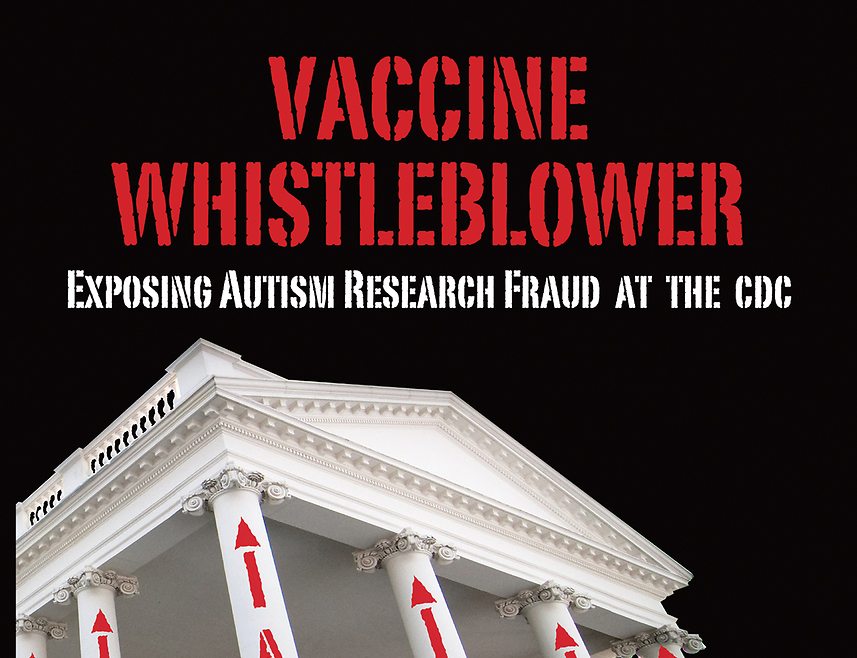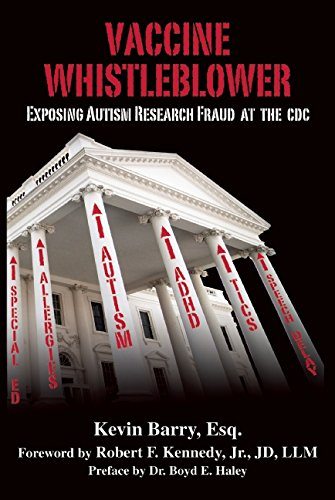Here we go again with the whole “CDC Whistleblower” thing, this time with a book about the recorded conversations between Brian J. Hooker and William Thompson. Well, not the whole conversations, of course. If they were to release the whole conversations, we might get the truth, and the truth always gets in the way of the antivax crowd. Instead, we get an edited transcript of the conversations between those two in which, according to them and the book’s editors and authors, there is some sort of massive cover-up at all levels of science, government, and public health. What’s the cover-up? As usual, vaccines are evil and whatnot.
I’m not going to review the whole book for you because Dr. Gorski has already done so, and Dorit Reiss has discussed the legal aspects of what is discussed in the book. You can go read his review and/or Prof. Reiss’ analysis and then come back, or stay here and read what I have to say about the failed attempts at epidemiology from both BS Hooker and Thompson.
Let’s start by reviewing BS Hooker’s credentials. He is a bioengineer and chemical engineer, not an epidemiologist, despite what the author of the book wants you to believe:
With the publication of Kevin Barry’s Vaccine Whistleblower: Exposing Autism Research Fraud at the CDC, any claims of credibility for the CDC’s science has collapsed. Barry built his book upon four legally taped conversations between CDC senior vaccine safety scientist Dr. William Thompson and Simpson College professor and epidemiologist, Dr. Brian Hooker.
Later in the book, in the transcript of one of the conversations between BS Hooker and Thompson, BS gets a list of things he needs to do to earn an “honorary” degree in epidemiology. Among those things was to look at some of the earlier studies that Thompson had coauthored. And BS did. He would go on to write a flawed paper that I critiqued here and ended up being retracted, as I told you about here. That paper alone should tell you everything you need to know about BS Hooker’s epidemiological understanding, but the transcripts given to us by his camp in the form of the book really reveal his ignorance.
So let’s go through the calls we have transcripts for and pick at the epidemiological and biostatistical missteps that Thompson suggests for BS Hooker.

The first transcript
In the first call we have a transcript for, Thompson tells BS to look at a study from Italy — and a reanalysis of that study — and see that there is an association between thimerosal in vaccines and tics. No, not autism, but tics. And both studies caution against concluding that it was the thimerosal because of the methodology and biologic plausibility of this. Also, the Italian study invited suBSects to participate, leading to a 70% participation rate. What the other 30% would have contributed is unknown. This is a huge source of bias and something that we should all watch out for.
Still, BS Hooker agrees to look at those studies and use them for his court case:
Dr. Thompson: The only thing I know for sure, is that I can say that pretty confidently, vaccines cause tics. We replicated that. The Barile article replicated that and showed that once you took into account the number of tests and reduced them down to constructs, the one thing you couldn’t get to go away was the tic effect.
Dr. hooker: Was the tic effect, right. I agree. And I’m even using that in my son’s vaccine court case, because he has tics and so, we have that. It’s been confirmed in several studies, not to mention your study and then the Barile study that was the reanalysis from 2012. And I’ll go back and look at those means on Tozzi as well.
Dr. Thompson: Look at the means. Look at the means, they’re very close. You could do a simple t-test and see they’re very close to significance. The other thing I wanted to ask you.
Yeah, they may be “very close to significance,” but that means nothing when you look at the entirety of the evidence. The authors tell us in those papers that there is bias, and that we must not jump to conclusions based on other factors, like biological plausibility. Still, Thompson and Hooker want to latch onto these studies and make something of them. Pretty par for the course for a couple of antivaxers.
Later in the first transcript, they discuss the numbers that led BS Hooker and his followers to cry out that African American males were more likely to get autism from vaccines than others in the group analyzed in the DeStefano paper. What is funny to me is that they discuss how drilling down into the data and splitting the cases and controls like they were doing leads to small numbers of cases and controls being compared:
Dr. Hooker: Okay, and one of the things I did find in this weird um, when I use the thirty-six-month cut-off for African American males, I only had seven cases in the after thirty-six months. Okay, so the cohort was getting small. So, I had like seven cases and I can’t remember how many controls. Obviously, the lion’s share of the cases were for individuals who got the MMR before thirty-six months. Now I, when I, I wanted to correct for low birthweight. So I threw out low birthweight. But what I found was that in my cases after, in the cases of individuals that got the MMR after thirty-six months, I wasn’t throwing out low birthweight, I was throwing out individuals that didn’t have birthweight reported at all. So you basically look at that and it is essentially saying it is the birth certificate cohort. Does that make sense? Let me, I can explain it one other way. When you look at the data and you look at African American male cases of autism, there are seven cases. There are four cases that did have a birth certificate and were normal birth weight and the remaining three cases didn’t have a birth certificate so they didn’t have birth weight at all.
That right there is a huge source of bias. When you compare five people here and six people there, even if you pick them at random, you’re going to find some differences that are big between the two groups. You need larger sample sizes to make sure that what you are seeing continues to be true on average and in the long run. It’s basic epidemiology, but Thompson and Hooker continued down that path, even as they recognized that these low numbers could be criticized and could be a problem.
As BS Hooker said:
Bill, I am not an epidemiologist by training.
And it shows.
The second transcript
In the second call we have a transcript for, Thompson seems horrified at the idea that no research group within and outside CDC wants to do an autism-vaccine study. Perhaps because that horse is dead and needs no more beatings?
Dr. Thompson: We’re going to have twelve hundred kids with autism as part of this uh study, um, with all their medical records and all their vaccine records abstracted. So, um, what’s amazing, now this is what’s going to be shocking to you, it shocked the crap out of me. They have ya know six different sites interviewing data and um they all put in proposals to do studies. So far there is about sixty proposals in, um, for people ready to do studies. Not a single one of them looks at vaccines, not one!
They probably don’t want to do a study like Thompson wants because the issue has been settled every which way before, because it is a huge waste of resources to look at autism and vaccines again.
In that same second transcript, there is a discussion about confidence intervals that needs to be noted. Thompson says this:
Dr. Thompson: You see that the strongest association is with those without mental retardation. The non-isolated, the non-mentally retarded, the effect is where you would think that it would happen. It is with the kids without other conditions, without the comorbid conditions. And the, ya know, honestly, I looked at those results, I had not gone through these hard copy papers, I don’t think I have ever gone through them since 2004 and I came across them, and I’m like “Oh my God” and this is 0.97 to 16 and it’s not statistically significant but odds ratio is 8 and if we would have added one more suBSect it probably would have been significant. I’m just looking that and I’m like. “Oh my God. I cannot believe we did what we did.” But we did. It’s all there. It’s all there. I have handwritten notes.
A confidence interval is the range of results that you will see 95 times out of 100 if you repeat the study many times. If your value includes 1.0, then there is a better than 5% chance that you will see no effect. Generally, you want confidence intervals to be nice and tight and not include 1.0. When you get a confidence interval that includes 1.0, you cannot rely on the results as being statistically significant. Now, did you catch that part about adding one more suBSect? Was Dr. Thompson suggesting that the results be manipulated some way? Or was he wishing that there were more suBSects in the study so the confidence interval wouldn’t be as wide and include 1.0?
Either way, the confidence interval could have shifted the other way to include 1.0 and more values under 1 than seen here. Then what? But, again, true to the antivax way, Dr. Thompson seems to wish that the results show what he wants them to show.
The third transcript
The third transcript is mostly about wishing that the data had gone the other way and confirmed the biases that BS Hooker and Thompson have about vaccines. They wish that non-African Americans had an association like the one seen in African American kids (when not adjusted for other factors). And then BS Hooker basically says that autism equals mental retardation, and that those who are autistic but not mentally retarded are the result of an “in vogue” diagnosis:
Dr. Thompson: Well, if you … The kids with mental retardation. …
Dr. Hooker: Right.
Dr. Thompson: … it’s probably, it’s probably unlikely that mercury exposure causes mental retardation.
Dr. Hooker: How well though … If you’ve got … You know, and you, like you said before, you’re not really the person to answer this but, how well do you have those records? Because a lot of times if you have an isolated autism case, you’re going to have mental retardation. I don’t … You know, I don’t know; I’m out in the community; I don’t really know many autistic kids that aren’t mentally retarded.
Dr. Thompson: Oh, I don’t know. I actually don’t know that for sure, but my reading of our own papers, the recent papers, is there’s a huge increase in the number of kids who don’t have mental retardation. That number is going, proportionately is going up.
Dr. Hooker: Right.
Dr. Thompson: So, I still … I still say …
Dr. Hooker: But that could be … Part of that could be a health-care-seeking behavior, because if it’s in vogue to get an autism diagnosis … And I deal with this as a parent all the time. You know, some genius walks up and tries to have a conversation with my kid, and I’ll look at the parent and say, “Oh, my son has autism. He’s non-verbal; he doesn’t speak.” And they’ll look at me and they’ll say, “Yeah, my kid has autism too.” And I’m just like, “What the fuck! Really?” We should be so lucky to have that kind of autism.
Later in the conversation, they try to compare thimerosal exposure to mercury exposure from fish and to lead poisoning… Do these guys even science? And they then dive into the antivaccine conspiracy theories about conflicts of interests (ignoring BS Hooker’s own, of course), hidden agendas, and Big Pharma interference.
In the last conversation in the book, there is more discussion about the papers that pointed to an increased chance of tics in children who got exposed to thimerosal. They try to explain away the lack of statistical significance in the findings and the recommendations to not look too much into the findings because there is an issue with biological plausibility. Yet again, they try to make sense of a world of science that they seem to not understand.
Again, check out the writers on other blogs who are reviewing the book and all of the discrepancies within it. Remember that you’re reading an edited version of conversations between two anti-vaccine people who have a lot to lose if it turns out that vaccines do not cause autism. Read carefully at the parts where they throw associates under the bus, and use some harsh language to describe those with whom they disagree. In essence, read the transcripts critically.
See, if you read the book with a total lack of understanding of what is going on, you might be tempted to think that a researcher at the CDC is actually revealing some pretty messed-up — perhaps even criminal — activities with regards to studies on vaccines and autism. But you know better, you’re more of a critical thinker than the hundreds of people who will read the book and be even more convinced of their own biases about vaccines. If you do end up reading the book, keep in mind the following things:
- Numerous other public and private research groups have found no association between any vaccine and autism. The CDC is not the only agency that looked into it. After Wakefield’s fraud of a paper back in 1998, everyone and their mother looked into vaccines and autism, and 17 years later, no one has found anything credible in terms of evidence that vaccines cause autism.
- BS Hooker has had the paper he worked on based on Thompson’s information thoroughly retracted. His methods didn’t add up, his conclusions didn’t add up, and…
- BS Hooker has a case pending in the vaccine court where he alleges that vaccines caused his son’s autism. He failed to disclose that in his paper (#2 above) and that is a huge conflict of interest. If it is proven that vaccines cause autism, BS Hooker is due to cash in a whole lot. If not, he won’t get what he wants, and with it would go his fame and glory among the antivax camp.
- Vaccines save lives. Period. End of post.

René F. Najera was born and raised in Mexico, and came to the US at age of ten. He attended the University of Texas at El Paso for a BS in Medical Technology, and worked for seven years as a medical technologist at a clinical laboratory while studying part-time towards a Master of Public Health in Epidemiology and Biostatistics from George Washington University. After completing his Master’s, he worked for six years as an infectious disease epidemiologist at the Maryland Department of Health and Mental Hygiene, doing disease surveillance and outbreak response. In 2013 Najera started the Doctor of Public Health program at Johns Hopkins University Bloomberg School of Public Health, and his thesis will be on the use of epidemiological methods to address social inequities.


